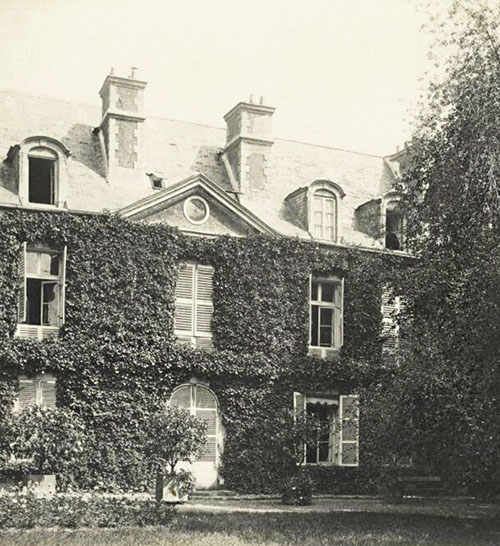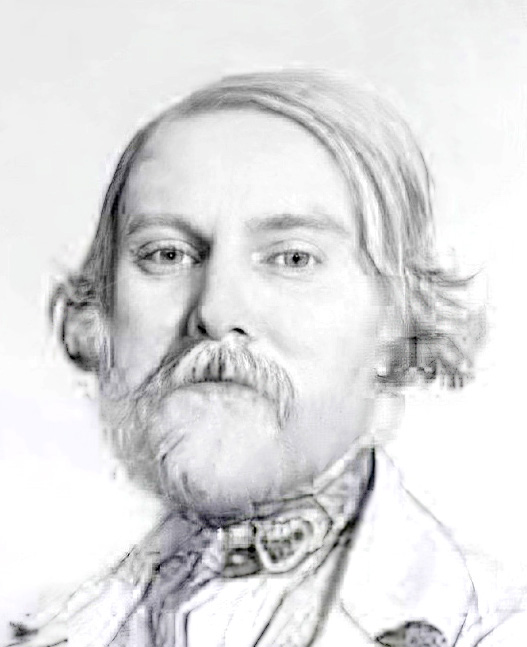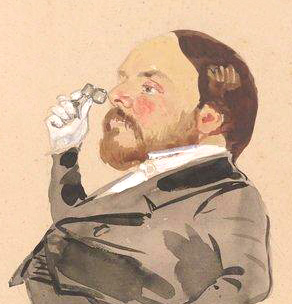Marie-Eugène-Frédéric Reiset (1815 – 1891), conservator Louvre
1st image: Soirée; 2nd: engraving of drawing by Ingres (reversed)(1844); 3rd: caricature by Giraud (1851).
Frédéric Reiset, as conservator, was tasked by de Nieuwerkerke16 to attend many vendredi-soirées. The uneven positioning of his eyes in the painting is corroborated by Ingres’ drawing. A caricature by Giraud11, highlighting the thick glasses that Reiset required due to farsightedness, was drawn at the afterparty of the soirée on March 28, 1851.
Reiset’s colleague, Viel-Castel43, held a critical opinion of him, largely because of his lack of formal art education. He stated: “Reiset, curator of drawings at the Louvre, and Villot72, curator of paintings, lack a true appreciation of art. They are collectors, not connoisseurs; they are narrow in their assessments, self-important, and believe themselves to be the only competent judges.”
Born into privilege, Reiset’s father was a banker and receiver general in Rouen. Upon his father’s death in 1835, the nineteen-year-old inherited a considerable fortune, which enabled him to indulge his passions —art, music, poetry, hunting, and fishing. He married his cousin Hortense, celebrated for her beauty, and embarked on a lengthy honeymoon in Italy. During this journey, Reiset became friends with Ingres39 and Flandrin79 and developed a deep admiration for art, particularly the works of Raphael, which inspired him to become a collector. With bad eyes, but an excellent visual memory, Reiset later could recall intricate details of artwork he had seen on this journey.
In 1849, Reiset’s observations on proposed changes for the Louvre earned him the position of conservator of the department of drawings and engravings, supported by Ingres and count de Morny48. At the time, the Louvre housed a collection of 36,000 drawings, including works by Michelangelo and Titian, which had largely been neglected. Reiset’s determined efforts led to the creation of a catalog for the collection. To avoid conflicts of interest, he ceased his private acquisitions and sold his collection in 1860 and, upon his retirement, in 1879, for 500,000 francs, equivalent to about three million euros today.
As an advocate for the appreciation of art, Reiset was among the first to suggest spacing paintings farther apart than the traditional arrangement, enhancing the visibility and appreciation of individual works.

Viel-Castel wrote in his diary how Reiset was strongly opposed to Princess Mathilde purchasing a castle near his wealthy family’s property at Lake Enghien. Her extramarital affair with de Nieuwerkerke, and their lack of constraints, would be a bad example for the neighborhood, and for his young daughter. Once Mathilde settled there (she bought the castle to house her many guests, such as Ingres), he became one of her most devoted admirers. Reiset’s daughter Marie even referred to de Nieuwerkerke as “grandfather.”
De Nieuwerkerke’s marble bust of the young and pretty Marie, which won a medal at the 1855 Salon, was regarded as one of his finest creations. It’s location is currently unknown.
In contrast to Viel-Castel’s criticism, Conservator Chennevières20 praised Reiset’s contributions, writing:
“All his qualities were against him: his sincerity, his naive honesty, his love of precision, his eagerness to obtain what he knew to be just and useful for his Louvre. [...] Mr. Reiset was one of the best curators that the Louvre will have known.”


